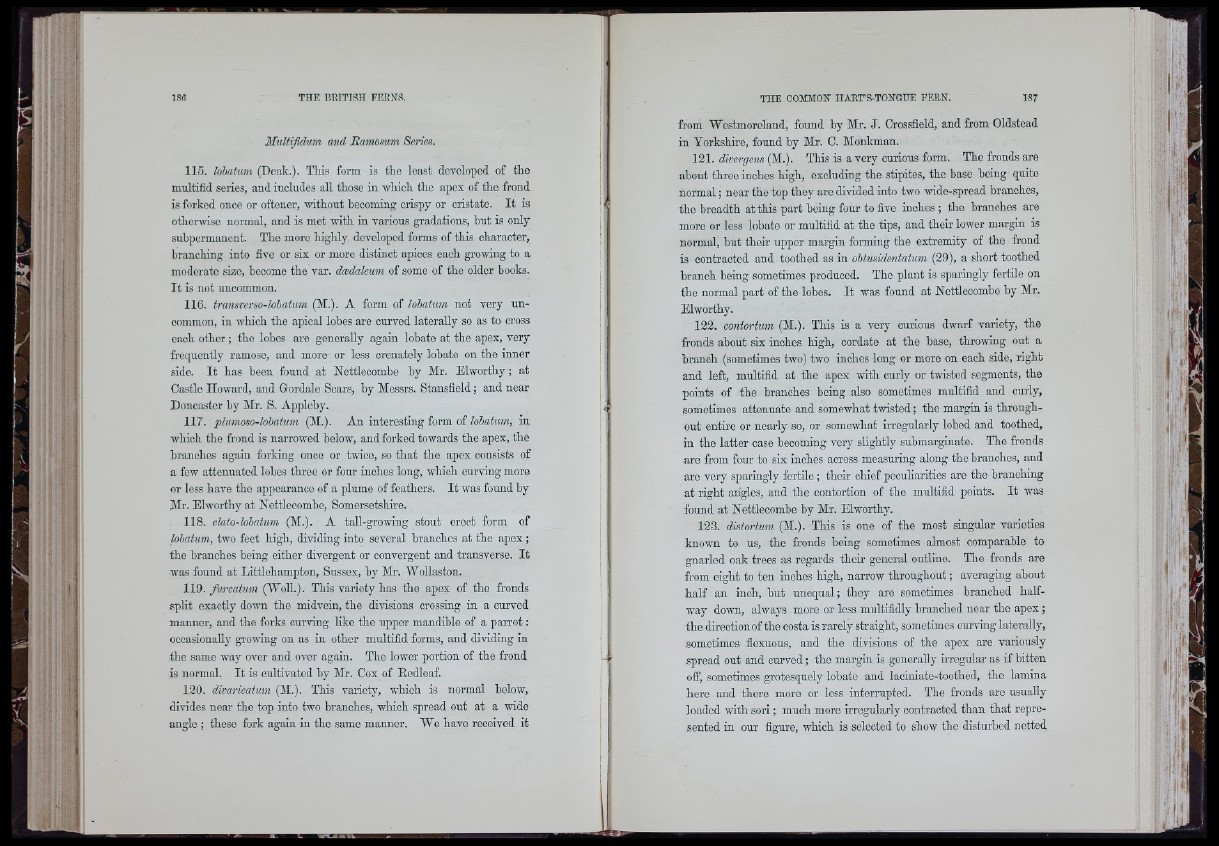
Multifidum and Eamosum Scries.
115. lobatum (Dcak.). This form is the least developed of tho
multifid series, and includes all those in which tho apex of tho frond
is forked once or oftener, without beooming crispy or cristate. It is
otherwise normal, and is met with in various gradations, but is only
subpormancnt. The more highly developed forms of this character,
branching into five or six or more distinct apices each growing to a
moderate size, become the var. daidaleum of some of the older books.
It is not uncommon.
116. transverso-lobatum (M.). A form of lobatum not very uncommon,
in which tho apical lobes are curved laterally so as to cross
each other; the lohes are generally again lobate at the apex, very
frequently ramose, and more or less crenately lobate on the inner
side. It has been found at Nettlecombe by Air. Elworthy; at
Castle Howard, and Gordale Soars, by Alessrs. Stansfleld; and near
Doncaster by Air. S. Appleby.
117. plumoso-lobatum (AI.). An interesting form of lobatum, in
which the frond is narrowed below, and forked towards the apex, the
branches again forking once or twice, so that the apex consists of
a few attenuated lobes threo or four inches long, which curving more
or loss have tho appearance of a plume of feathers. It was found by
Air. Elworthy at Nettlecombe, Somersetshire.
118. elato-lohatum (AI.). A tall-growing stout erect form of
lobatum, two feet high, dividing into several branches at the apex ;
the branches being cither divergent or convergent and transverse. It
was found at Littlehampton, Sussex, by Air. AVollaston.
119. furcatum (AVoll). This variety has the apex of the fronds
split exactly down tho midvem, the divisions crossing in a curved
manner, and tho forks curving like the upper mandible of a parrot:
occasionally growing on as in other multifid forms, and dividing in
the same way over and over again. The lower portion of the frond
is normal. It is cultivated by Air. Cox of Rodleaf.
120. dimrieatum (AI.). This variety, which is normal below,
divides near the top into two branches, which spread out at a wide
angle ; these fork again in tho same manner. AVe have received it
from AVestmoreland, found by Mr. J. Crossfield, and from Oldstead
in Yorkshire, found by Air. C. Alonkman.
121. divergens (M.). This is a very curious form. The fronds are
about threo inches high, excluding the stipites, the base being quite
normal; near the top they are divided into two wide-spread branches,
the breadth at this part being four to five inches ; the branches are
more or less lobate or multifid at the tips, and their lower margin is
normal, but their upper margin forming the extremity of the frond
is contracted and toothed as in obtusidentatum (29), a short toothed
branch being sometimes produced. The plant is sparingly fertile on
the normal part of the lobes. It was fonnd at Nettlecombe by Air.
Elworthy.
122. contortum (AI.). This is a very curious dwarf variety, the
fronds about six inches high, cordate at the base, throwing out a
branch (sometimes two) two inches long or more on each side, right
and left, multifid at the apex with curly or twisted segments, the
points of the branches being also sometimes multifid and curly,
sometimes attenuate and somewhat twisted; tho margin is throughout
entire or nearly so, or somewhat irregularly lobed and toothed,
in the latter case beooming very slightly suhmarginate. The fronds
are from four to six inches across measuring along the branches, and
aro very sparingly fertile; thoir chief peculiarities are tho branching
at right angles, and the contortion of the multifid points. It was
found at Nettlecombe by Mr. Elworthy.
123. disiortum (AI.). This is one of tho most singular varieties
known to us, the fronds being sometimes almost comparable to
gnarled oak trees as regards thoir general outline. The fronds are
from eight to ten inches high, narrow throughout; averaging about
half an inch, hut unequal; they aro sometimes branched halfway
down, always more or less multifidly branched near the apex;
the direction of the oosta is rarely straight, sometimes curving laterally,
sometimes flexuons, and the divisions of the apex are variously
spread out and curved; the margin is generally irregular as if bitten
o£F, sometimes grotesquely lobate and laciniate-toothed, the lamina
here and there more or less interrupted. The fronds are usually
loaded with sori; much more irregularly contracted than that represented
in our figure, which is selected to show the disturbed netted
1, ll
'r i/I-l'
(i[
fil
I
4
I I
(